Health & Safety Information
FOR CURRENT COVID-19 POLICIES AND GUIDELINES, PLEASE VISIT STANFORD UNIVERSITY'S COVID-19 DASHBOARD
Come prepared
There are health and safety risks associated with any natural environment, and good practices can reduce risk. Before you visit Jasper Ridge, read through the information here, think about the conditions you may experience, and plan accordingly.
Field Work Advisements:
- Please note children under 14 are not allowed. Requests to bring younger children must be brought to the Executive Director for approval prior to the tour. There must be special, mitigating circumstances for approval. Children under 14 are not allowed to cross the Searsville Dam. For safety reasons, strollers are not allowed. No pets are allowed on the preserve.
- Double check to make sure your immunizations are up-to-date, including tetanus (often shown in immunization records as Td or Tdap).
- Protect yourself against injury by carrying water, wearing sturdy, closed-toes shoes, and wearing a hat/sunglasses/sunscreen as needed.
- Reduce the likelihood of insect-borne diseases by following the guidance of the Centers for Disease Control and Prevention (CDC) on diseases transmitted by mosquitoes, fleas, and ticks. The CDC information includes EPA-registered insect repellents, repellents to use on clothing, what kind of clothing to wear, etc., to help protect you.
- Always work with another person, and let people know where you will be and when they can expect your return.
- Consider carrying a basic first-aid kit to treat minor issues that may arise in the field (while Jasper Ridge is close to the university, this is a good opportunity to develop this good field work habit). You can put a first-aid kit together yourself or purchase one. Here are a few suggestions for purchase or to use as a guide: REI day hiker kit, Lifeline kit, or one of the Adventure Medical kits. Basic training in first aid provides valuable life skills. Some reminders on basic first aid procedures and techniques are listed in sections below.
- Make sure someone in your group has a map of the Jasper Ridge trails and a card with JR staff phone numbers. Both are available in the Sun Field Station.
More detailed information is provided below.
Reporting Emergencies
If you need to report an emergency at Jasper Ridge, call the San Mateo County Sheriff Dispatch at 650-363-4911 or 911. Using the Sheriff Dispatch number will like provide the fastest response. Provide the dispatcher with the gate address of the nearest Jasper Ridge gate (see illustration below). Then Contact a Jasper Ridge staff member to help guide emergency responders to you. Use the trail map to describe where you are. Gate addresses and phone numbers are on the emergency card below, which you can download and print as a wallet-size version by clicking on the illustrations.
In the event you do not have a cell phone, a phone for emergency use is located in the Sun Field Station near the north entrance to the lab next to the copy machines. In an emergency, press 911 (no prefix). If you are outside, and an off-site private residence is closer, you can try there first.
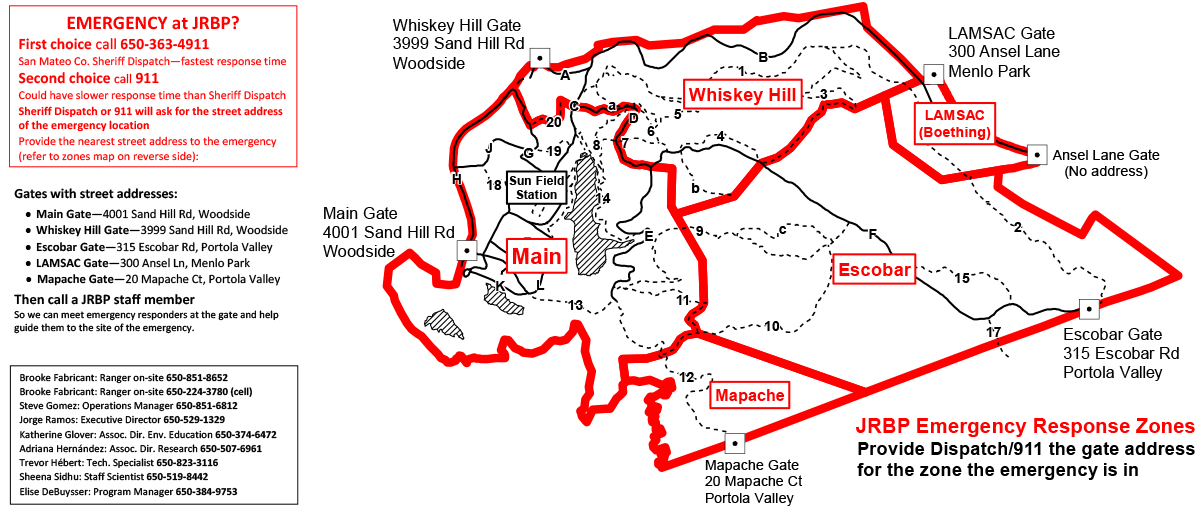
Injury reporting and treatment
Always let your principal investigator, instructor, and/or advisor know about any injuries, even if minor. You may need to complete a SU17 form.
If you are injured while working as part of a Stanford University paid program (Stanford employee/faculty/staff, post-doc/research associate, etc.) please visit or contact the Stanford University Occupational Health Center (Environmental Safety Facility, 480 Oak Road, Room B15, Stanford, CA 94305-8007; Phone: 650-725-5308) as soon as possible.
If you are a Stanford student (unpaid) please contact or visit the Vaden Student Health Center.
Advisements and information sources
TICKS
The Lyme disease bacterium, Borrelia burgdorferi, is spread through the bite of infected ticks. In our area, the carrier is the Western black-legged tick, Ixodes pacificus. Only nymphs and adult females transmit the bacterium to humans. Adult ticks are most active from fall through spring; nymphs are most active mid-winter into fall. A few percent of adult ticks carry the bacterium, and up to 15 percent of nymphs carry the bacterium.
Below: a tick species from the eastern US that resembles the Western black-legged tick:
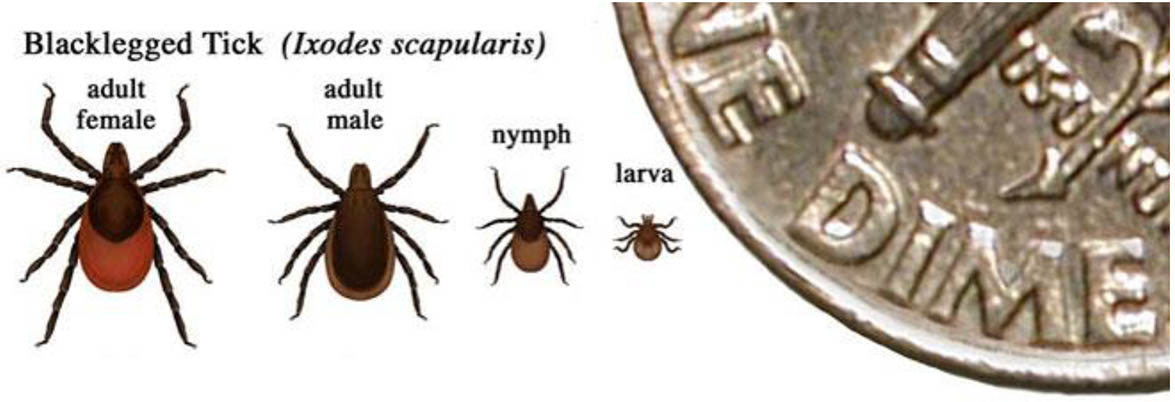
Avoidance:
- Wear long pants and sleeves.
- Treat exterior clothing (not undergarments) and shoes with permethrin.
- Wear DEET-containing repellent on exposed skin (neck, wrists, ankles), but avoid applying it to plastics.
- Do a full-body tick check after hiking or field work (check under arms, hair and hairline, groin).
- After your outdoor work, launder your clothing right away, or keep it outside, or in a sealed plastic bag, until laundering.
- Do not wear the same clothing again until its laundered—ticks can be very small and stay on clothing; they will crawl to other areas unless contained, and they can live for weeks between feedings.
Tick Removal:
It takes 24-48 hours for a tick to transmit the Lyme bacterium after biting, so it's important to check yourself for ticks and remove them as soon as possible.
- Grasp the tick with with a tick removal tool (available at the Sun Field Station) or tweezers as close to your skin as possible. Be careful not to squeeze the tick's abdomen.
- Gently pull the tick straight upward from the skin, no twisting or unscrewing.
- Do not attempt removal by using nail polish remover, kerosene, or Vaseline.
If you find a tick on you, and you think it bit you more than 24 hours earlier:
- Remove the tick and put it in a sealed container or ziplock bag with 1-2 drops of water (not alcohol) so it doesn’t dry out.
- Get seen at the Vaden Student Health Center or contact the Environmental Safety Facility, 480 Oak Road, Room B15, Stanford, CA 94305-8007; Phone: 650-725-5308. You may be advised to have the tick tested and/or take a course of antibiotics.
Tick testing:
To have the tick tested for the Lyme bacterium or certain other diseases, bring the tick to the San Mateo County Lyme Disease and Tick Testing Lab (Mon - Fri, 8AM-12PM or 1PM-5PM) located at 225 West 37th Avenue (Room 104), San Mateo, CA 94403. To contact the laboratory, call (650) 573-2500. There is a $25 processing fee for testing the tick; THE TICK MUST BE ALIVE for the test. They can identify the tick species at no cost.
Additional information on Ticks and Lyme disease:
- Lyme disease in California
- Centers for Disease Control and Prevention information on Lyme disease
- Published survey of tick-borne pathogens at JRBP and other areas in northern California
RATTLESNAKES
Be attentive. Two of the most common snakes native to the area are the gopher snake and the Northern Pacific rattlesnake, also called Western rattlesnake (Crotalus oreganus oreganus). While rattlesnakes have a poisonous bite and gopher snakes do not, they are similar in color and length (often several feet long or longer). Besides the rattlesnake’s distinctive tail, the easiest way to tell the difference between the two snakes is by the shape of the head. A gopher snake head is the same width as its body, whereas a rattlesnake head is broader than the body and triangular in shape.
Below: Northern Pacific rattlesnake, also called Western rattlesnake (Crotalus oreganus oreganus) at Jasper Ridge.
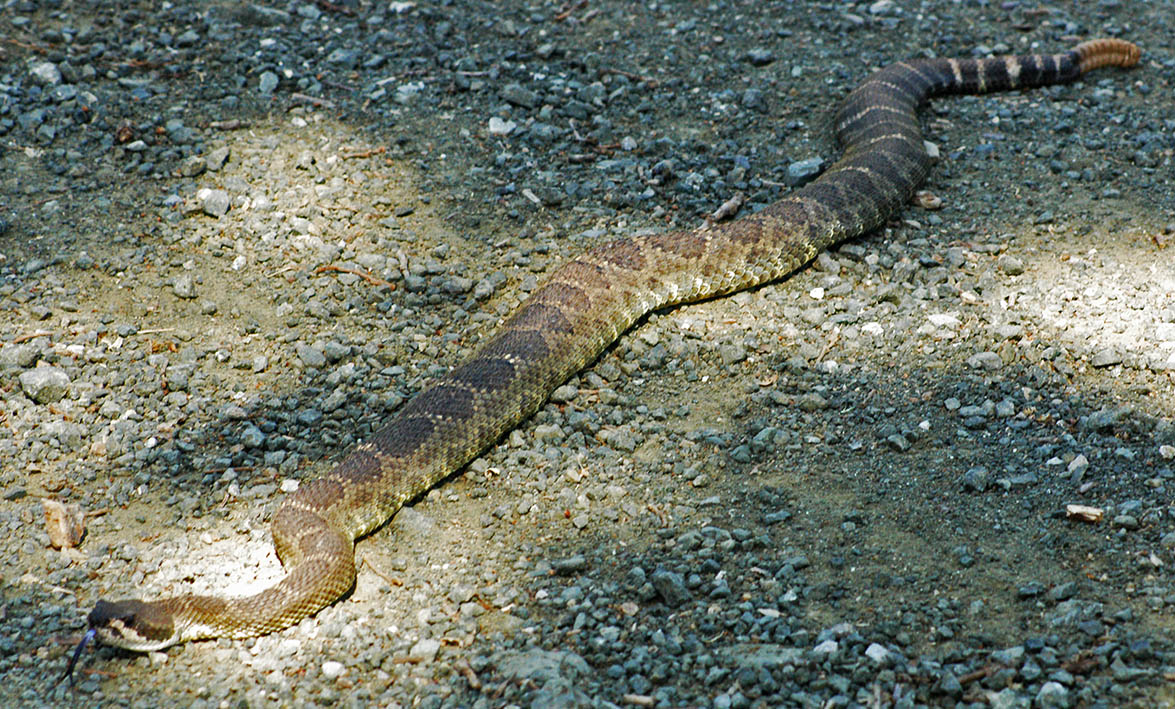
If you see a snake that you cannot identify as safe, back away to a safe distance (at least 12 feet), and notify others nearby to avoid it. DO NOT attempt to capture, poke, move, or provoke the snake.
If bitten by a snake, stay calm; identify the kind of snake if you can.
- If possible, wash the area with soap and water.
- Remove rings, watches, constrictive clothing.
- Immobilize the affected area if possible.
- Get transported safely to the nearest medical facility (avoid speeding or panicking, as the risk of a crash and the elevated heartrate will make the situation worse).
- Keep in mind that the great majority of snakebites require only observation or supportive care (IV fluids, etc.) and not antivenom medication.
Do NOT cut or suck on the wound, do not apply a tourniquet. Avoid elevating the affected area above the level of the heart.
POISON OAK
This a woody shrub or small tree (in sunny areas) or vine (in shaded areas) that is prevalent at Jasper Ridge and most of the natural areas in our region. Contact with the leaves, the stem (it does not have leaves in the winter), or the white berries can cause a very itchy red rash, sometimes with blistering. The leaves consist of three leaflets with the stalk of the central leaflet being longer than those of the other two; however, leaves occasionally have additional leaflets. Leaves of true oaks, which are superficially similar, grow singly, not in groups.
Below: Poison oak (Toxicodendron diversilobum) at Jasper Ridge (photo by Alice Cummings.)

The field station stocks Tecnu, a lotion you can wash with to remove the irritant. If you know that you are highly allergic to poison oak, discuss with the Jasper Ridge staff about wearing a protective, disposable coverall.
Additional information:
Poison ivy, oak, and sumac: overview, symptoms, causes, treatment
BEE STINGS
If you know that you are allergic, bring your EpiPen. If you are allergic and get stung, seek immediate medical attention. If you use your EpiPen, go to the hospital immediately.
If you have never been stung before and develop a concerning reaction after being stung, go to the Emergency department or, if needed, call 911.
Reactions to be concerned about including the following:
- A rash that spreads to large areas of the body
- Rapidly spreading swelling
- Any swelling of the tongue or throat
- Difficulty speaking or swallowing
- Wheezing
- Fainting
- Chest Pain
For most people, most stings require only first aid care:
- Remove the stinger immediately (scape it away with a credit card or similar; don't pinch it).
- Apply ice or a cold pack.
- Take an antihistamine (e.g., Benadryl, loratidine, cetirizine, etc.) if there is itching.
- Wash the area with soap and water.
- Apply topical hydrocortisone cream if the area is locally swollen and/or itchy.
- Watch for problems or infection over the next few days (not common but possible) and get checked if you have concerns.
SUN
The sun can burn your skin, damage your eyes, and make you dehydrated. Protect your skin from the sun with clothing (hats, pants, etc.) and sunscreen, and protect your eyes with UV-protective sunglasses. Carry water, and drink regularly, before you feel dehydrated.
If you get hot, dizzy, nauseated, cramps, or similar, take a rest in the shade, fan yourself, and drink water. Let someone else know what you feel. Avoid heat for the rest of the day, and drink lots of water. If you get worse at any time, get evaluated at the nearest medical center right away.
Below: Symptoms and first aid measures for heat-related illness (from https://www.osha.gov/SLTC/heatstress/heat_illnesses.html )
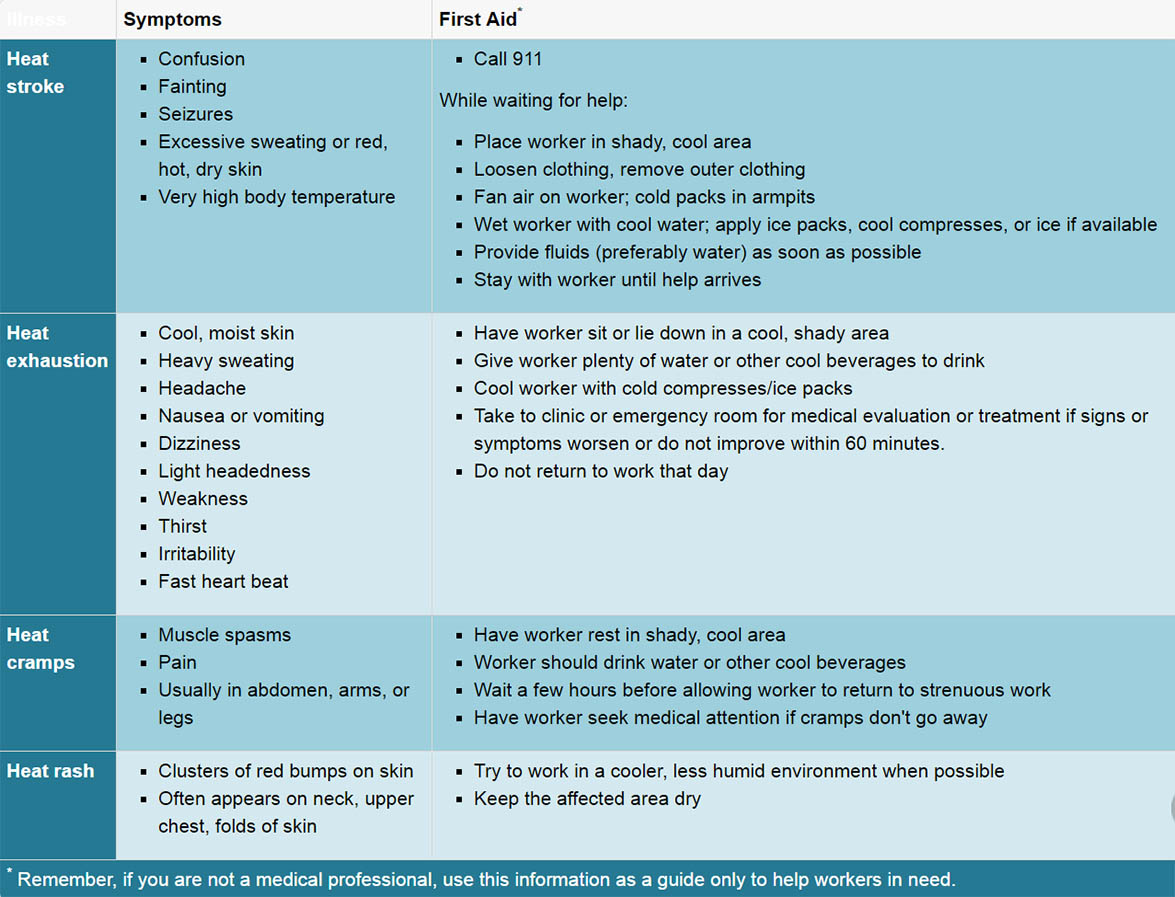
POLLEN
Pollen causes allergies for many people, and with JRBP's high diversity of plants, the season of allergenic pollen is long. If your allergies flare up, consider use of an antihistamine (Benadryl, Claritin, Zyrtec, or any of the generics of these). Take a shower when you get home to get the pollen off and out of your hair. Change your clothes; the clothes you wear in the field will have pollen on them and should be washed before you wear them again. If you are especially sensitive, you may want to shower and change clothes at the Sun Field Station before leaving Jasper Ridge; please check with a JRBP staff member about these facilities.
SLIPPING, TRIPPING
Good footwear is helpful for maintaining footing and protecting your feet against rocks, sticks, and other hazards. However, more important is attentiveness. Watch your step and this will protect you far more than any type of shoe. Avoid smooth-soled shoes, as these will provide poor traction in wet areas, mud, steep gravelled trails, or areas with layers of debris (leaves) on the ground. Hiking boots are nice to have in wet or muddy areas, are more protective against bites, and provide some ankle support and stability.

MOUNTAIN LIONS (aka cougars, pumas)
Though rarely seen by people, mountain lions may be active at any time of day throughout JRBP.
- Never approach a mountain lion.
- If you spot a mountain lion and the animal is unaware of you, alter your route to move away from it, but do not run or turn your back.
- Most mountain lions will try to avoid confrontation. Always give them a way to escape.
- Do all you can to appear larger; stand upright, raise your arms, raise your walking stick, open your jacket.
- Never bend over or crouch down, avoid looking like a four-legged prey animal, as this may trigger a pounce response in a mountain lion.
- If the lion behaves aggressively, wave your arms slowly and speak firmly in a loud voice, and throw objects like the water bottle in your hand. The goal is to convince it that you are not prey and may be dangerous yourself.
- Try to remain standing to protect your head and neck.
- If attacked, fight back!! Use rocks, jackets, sticks to turn away the mountain lion.
Additional information on mountain lions:
- Biology and behavior
- A workshop and report by the Rising Environmental Leaders Network on mountain lions at Jasper Ridge
WILD TURKEYS
Turkeys are becoming a nuisance in many parts of California. For more information, read a brochure from the California Department of Fish and Wildlife. The city of Davis passed a resolution in 2016 to begin trapping and relocating wild turkeys.
Below: wild turkey outside the field station building at Jasper Ridge. Flocks of two dozen turkeys have been seen at Jasper Ridge.
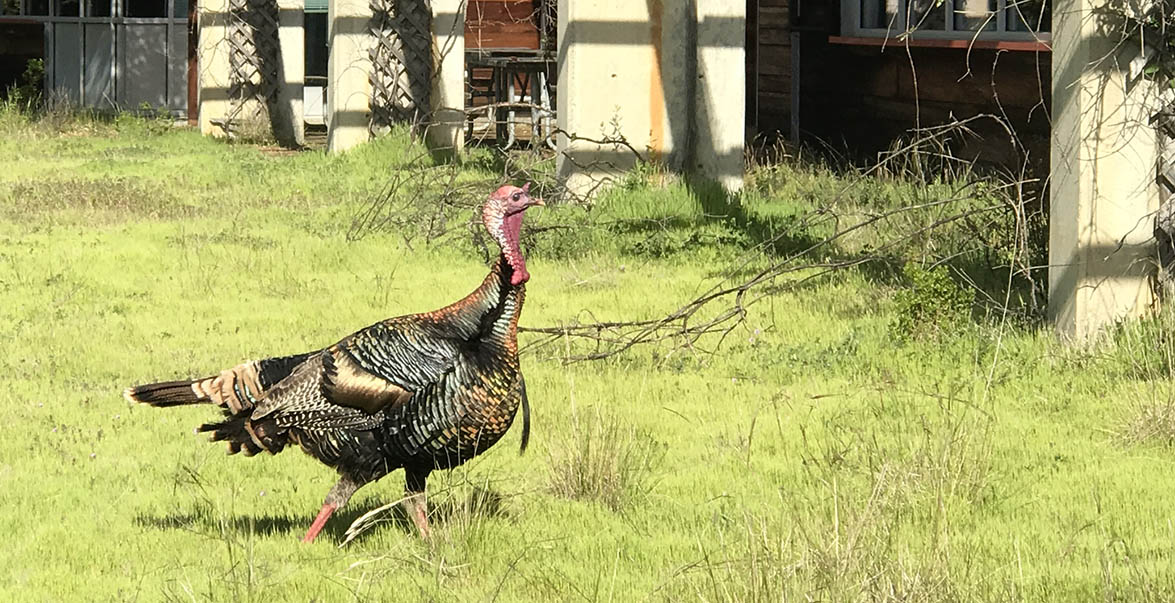
If approached by a wild turkey at Jasper Ridge:
- Do not run away; use whatever you’re carrying to block its approach toward you, e.g, a backpack, bag, or walking stick.
- Report the encounter to a Jasper Ridge staff member.
WEST NILE VIRUS
West Nile virus is present in San Mateo County. The main vectors of WNV are Culex mosquitoes; they become carriers if they bite an infected bird, and then can transmit the disease to humans. The San Mateo County Mosquito and Vector Control District conducts three major efforts at Jasper Ridge to reduce WNV risk. They monitor and sample mosquitoes along the lake margin; they maintain a flock of sentinel chickens that are tested for WNV; and they disperse mosquito larvicide by helicopter to open-water areas of Searsville Lake roughly every three weeks during the summer. You can help protect yourself by wearing DEET-based repellent to prevent mosquito bites, especially in the early morning and near dusk, which are the primary times when the mosquitoes that transmit WNV are biting.
If you see a dead bird in the field, leave it where it is, and report it to Jasper Ridge staff to determine whether it should be sent in for testing.
The California Department of Public Health has a comprehensive website on WNV, including weekly updates on numbers of cases.
CHIGGERS
Chiggers are the larvae of a certain group of mites, often called "harvest mites," and the most common species in our area is Trombicula alfreddugesi. Chiggers seek parts of the human body that are warm, moist, and constricted by clothing, such as ankles, waistline, and armpits. The larvae attach to the host and feed, but typically go unnoticed during this time. Itching generally begins a few hours later, and is likely an allergic response to the mite's salivary secretions. The itching can be very intense and can last a couple of weeks. Chiggers tend to occur in leaf litter, so staying on well-worn trails will reduce contact. Insect repellent helps deter chiggers, but an added preventive measure is to change clothes before the chiggers make it from your clothing to your skin, i.e. as soon as you leave the field. Chiggers are primarily a problem during the dry season (late spring through early fall).
For more information, visit the Urban Entomology website, which discusses chiggers and also ticks, fleas, etc.



